
Harnett County is a county located in the U.S. state of North Carolina. As of the 2010 census, the population was 114,678. Its county seat is Lillington, and its largest city is Dunn.

Holdenby House is a historic country house in Northamptonshire, traditionally pronounced, and sometimes spelt, Holmby. The house is situated in the parish of Holdenby, six miles (10 km) northwest of Northampton and close to Althorp. It is a Grade II* listed building.

The Hall of Memory in Centenary Square, Birmingham, England, designed by S. N. Cooke and W. N. Twist, is a war memorial erected 1922–25, by John Barnsley and Son, to commemorate the 12,320 Birmingham citizens who died in World War I.

The Barber Institute of Fine Arts is an art gallery and concert hall in Birmingham, England. It is situated in purpose-built premises on the campus of the University of Birmingham.
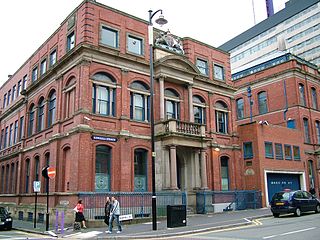
The Birmingham Assay Office, one of the four assay offices in the United Kingdom, is located in the Jewellery Quarter, Birmingham. The development of a silver industry in 18th century Birmingham was hampered by the legal requirement that items of solid silver be assayed, and the nearest Assay Offices were in Chester and London. Matthew Boulton and Birmingham's other great industrialists joined forces with silversmiths of Sheffield to petition Parliament for the establishment of Assay Offices in their respective cities. In spite of determined opposition by London silversmiths, an Act of Parliament was passed in March 1773, just one month after the original petition was presented to Parliament, to allow Birmingham and Sheffield the right to assay silver. The Birmingham Assay Office opened on 31 August 1773 and initially operated from three rooms in the King's Head Inn on New Street employing only four staff and was only operating on a Tuesday. The first customer on that day was Matthew Boulton.

Clandown is a village lying north of Radstock in Somerset, England, just off the Fosseway. It is 1 mile (1.6 km) north of Radstock. The nearby Bowlditch Quarry is a 0.25 hectare geological Site of Special Scientific Interest.
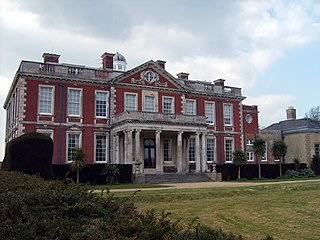
Stansted Park is an Edwardian country house in the parish of Stoughton, West Sussex, England. It is near the city of Chichester, and also the village of Rowlands Castle to the west over the border in Hampshire.

The Moseley School of Art on Moseley Road, Balsall Heath, Birmingham, England was built as the first municipal branch School of Art in Birmingham.
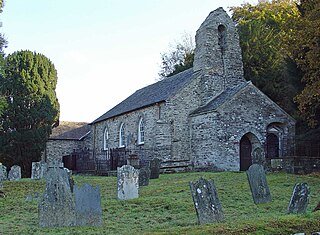
Manordeifi is a parish and community in the hundred of Kilgerran, in the northeast corner of Pembrokeshire, Wales. The population of the community in 2001 was 478. It has an elected community council and is part of the Cilgerran electoral ward for the purposes of elections to Pembrokeshire County Council.
Afon Cych is a tributary of the River Teifi in south-west Wales. It is 13 km long, passes through a number of small settlements on the border between Pembrokeshire and Carmarthenshire, and is significant in Welsh legend.

Bromley House Library is a subscription library in Nottingham.

St Mary Magdalene's Church, Lillington is the Church of England parish church of Lillington, Warwickshire, a part of Royal Leamington Spa with a population of about 11,000. The church is at the junction of Vicarage Road and Church Lane. It has been a Grade II listed building since 1949.
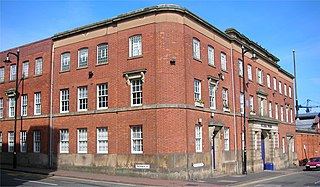
The Victoria Works is a Grade II listed building in the Jewellery Quarter of Birmingham, England. It was built in 1839–40 for Joseph Gillott, who manufactured pen nibs, and was one of the first purpose-built factories in the Jewellery Quarter. It is situated opposite the Argent Centre, another building constructed for industrial use around the same period. The factory was one of the largest of its kind, with nearly 600 workers. Steam engines of 60 horsepower powered the mass production of the nibs.

The former Manchester Law Library is a Grade II* listed building in the Venetian Gothic style at 14 Kennedy Street, Manchester. "The building is noteworthy by virtue of having been built for the purposes of a law library and, London and the old universities aside, it is believed to have performed this function for a period longer than any other provincial law library".

The British Muslim Heritage Centre, formerly the GMB National College, College Road, Whalley Range, Manchester, is an early Gothic Revival building. The centre was designated a Grade II* listed building on 3 October 1974.
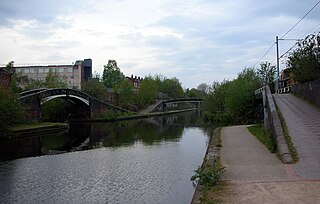
The Icknield Port Loop is a 0.6-mile (1 km) loop of the eighteenth-century-built Old BCN Main Line canal in Birmingham, England, about 2 miles (3 km) west of the city centre, which opened to traffic on 6 November 1769 and in some definitions includes its straighter bypass built in September 1827, a 550-yard (500 m) section of the New BCN Main Line. Most of the 56 acres (23 ha) of land thereby enclosed is derelict meaning the canal serves the Canal & River Trust maintenance depot at Icknield Port and conveys water from Edgbaston Reservoir to the BCN Main Line. The enclosed land has no pedestrian or vehicular access. Icknield Port (Loop) takes its name from the Roman Icknield Street which passed nearby, the exact route of which is unknown.

Ye Olde Dolphin Inne is a Grade II listed pub, on Queen Street, in the city of Derby, England.

St James’s House is a Grade II listed office building in Birmingham, England.

The Antelope, now housing a restaurant called Hajee's Spices, is a grade II listed building on the Stratford Road in Sparkhill, Birmingham, England. It opened as a public house called The Antelope in 1924.
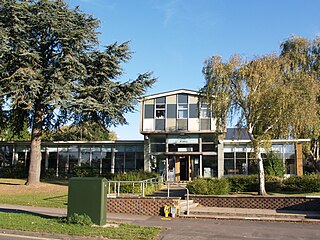
Henry Fedeski ARIBA (1907–1993) was a British architect, responsible for several buildings in the Leamington Spa area, including Lillington County Library, and the Roman Catholic Church of Our Lady, Valley Road, Lillington, both Grade II listed. He co-founded Rayner and Fedeski Architects.



















